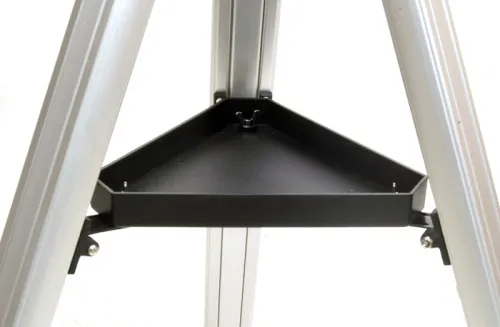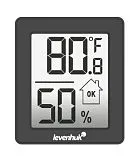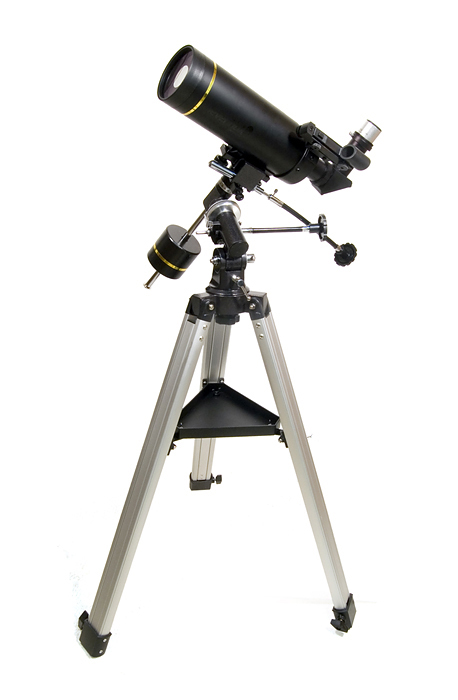Levenhuk Skyline PRO 80 MAK Telescope
Maksutov-Cassegrain telescope. Objective lens diameter: 80mm. Focal length: 1000mm
| Product ID | 30075 |
| Brand | Levenhuk, Inc., USA |
| Warranty | lifetime |
| EAN | 5905555002170 |
| Package size (LxWxH) | 32.3x15x9.4 in |
| Shipping Weight | 21.2 lb |
Levenhuk Skyline PRO 80 MAK is an entry-level model in the Skyline PRO series. The Maksutov-Cassegrain optical design of this telescope provides for a compact tube and high-quality views. This is a perfect tool for observations of deep-sky objects, like star clusters, binary stars, nebulae and other galaxies. However, you would be surprised with its capabilities during planetary observations. The telescope is set up on a reliable German equatorial mount. Levenhuk Skyline PRO 80 MAK is wonderful for observations in the countryside, as you would have no trouble carrying it there or setting it up for your observations.
The lenses and mirrors are fully multi-coated, which allows for maximum light gathering and increases their service life. The sturdy and lightweight aluminum tube is set up on an equatorial mount with slow-motion controls. You can also install the equatorial computerized drive system (purchased separately) on your mount. It is equipped with setting circles which – after a quick adjustment – allow for locating objects by their celestial coordinates and tracking them with just a turn of an equatorial control. The adjustable-height tripod has a practical accessory tray where you can store all your tools. The focuser has the standard T-thread, which allows you to attach an SLR camera using an adapter and use your telescope for astrophotography.
Levenhuk Skyline PRO series was designed for advanced and demanding astronomers and includes a range of different models. The one thing in common is maximum precision and reliability during observations and astrophotography, high-quality materials and optics.
The kit includes:
- Telescope optical tube
- Equatorial mount
- Aluminum tripod with an accessory tray
- Red Dot finder scope
- SUPER 10mm eyepiece, 1.25"
- SUPER WA LER 25mm eyepiece, 1.25"
- M42 adapter ring
- 90° diagonal mirror
- Slow-motion control knobs
- Counterweight
- User manual and lifetime warranty
| Product ID | 30075 |
| Brand | Levenhuk, Inc., USA |
| Warranty | lifetime |
| EAN | 5905555002170 |
| Package size (LxWxH) | 32.3x15x9.4 in |
| Shipping Weight | 21.2 lb |
| Optical design | catadioptric |
| Optical scheme | Maksutov-Cassegrain |
| Optics material | optical glass |
| Optics coating | standard |
| Primary mirror diameter (aperture), in | 3.1 |
| Focal length, in | 39.4 |
| Highest practical power, x | 160 |
| Aperture ratio | f/12.5 |
| Resolution threshold, arcseconds | 1.73 |
| Limiting stellar magnitude | 12 |
| Eyepieces | SUPER 10mm, Super WA LER 25mm |
| Eyepiece barrel diameter, in | 1.25 |
| Finderscope | red dot |
| Focuser | 1.25" |
| Tripod | aluminum |
| Tripod height (adjustable), in | 27.95–48.43 |
| Accessory tray | ✓ |
| Telescope control | manual |
| Mount | equatorial, EQ1 |
| Drive | only along the right ascension axis |
| Slow-motion controls | along both axes |
| Mount weight, lbs | 7.9 |
| Power supply | CR2032 type battery – 1 pc. (not included) |
| User level | experienced users |
| Assembly and installation difficulty level | complicated |
| Observed object | deep-sky objects, planets of the Solar System |
Is there any additional information you might need?
The red dot finder is a zero magnification pointing tool that uses a coated glass window to superimpose the image of a small red dot onto the night sky. The red dot finder is equipped with a variable brightness control, azimuth adjustment knob, and altitude adjustment knob. The finder is powered by a 3-volt lithium battery located underneath at the front.
To use the red dot finder, simply look through the sight tube and move your telescope until the red dot overlaps the object. Make sure to keep both eyes open when sighting. Like all finderscopes, the red dot finder must be properly aligned with the telescope before use. This is a simple process using the azimuth and altitude adjustment knobs.
Open the battery compartment by pulling down the cover and remove the plastic shipping cover over the battery.
Turn on the red dot finder by rotating the variable brightness control clockwise until you hear a click. Continue rotating the control knob to increase the brightness level.
Insert a low power eyepiece into the focuser. Locate a bright object and aim the telescope so that the object is in the center of the field of view.
With both eyes open, look through the sight tube at the object. If the red dot overlaps the object, your red dot finder is perfectly aligned. If not, turn its azimuth and altitude adjustment knob until
the red dot overlaps the object.
Is there any additional information you might need?
https://www.levenhuk.com/catalogue/spotting-scopes/levenhuk-blaze-90-plus-spotting-scope/ .
Which motor drive will I need for astrophotography? Speaking of versatility - ease of use, compact dimensions, ability to take astro photos - which telescope can compete with this model?
I've already asked about the installation of Red Dot finderscope, but in the answer I got installation of optical finderscope is described. I would like to get some info on how to correctly install finderscope included in the kit.
And I don't understand a damn thing in the user manual.
2. We recommend you use a remote control with your camera to prevent shaking while shooting photos.
2. We recommend you use a remote control with your camera to prevent shaking while shooting photos.










